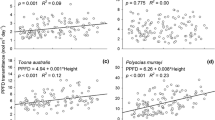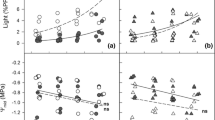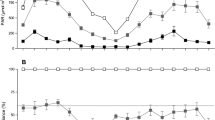Abstract
Expansion of shrubs into grasslands is often accompanied by a reduction in understory light and an associated reduction of shade-intolerant species. However, effects of specific canopy architectural characteristics on the light environment under shrub thickets are unknown. Our objective was to determine what characteristics of canopy architecture most influence understory light in monospecific shrub thickets. We quantified understory light and canopy architecture for five shrub species in the eastern United States that have a history of expansion, and we used multiple regression to determine which canopy characteristics best predicted light attenuation and relative contribution of sunflecks. Measurements included leaf angle, leaf azimuth, branch bifurcation ratio, leaf area index (LAI), canopy depth (the vertical distance from the bottommost leaf to the top of the canopy), and leaf area density (LAD) as well as understory photosynthetic photon flux density (PPFD). The best predictor of light attenuation and the occurrence of sunflecks for all species was canopy depth. Multiple leaf and plant-level traits were correlated with canopy depth but not with LAI or LAD. The invasive shrub Elaeagnus umbellata had the lowest understory light levels of the species examined although LAI values for Morella cerifera and Rhododendron maximum were higher. Branch bifurcation ratios for E. umbellata were significantly higher than for other species and this likely contributed to the differences in light attenuation and suppression of sunflecks. The potential of shrubs to intercept light is primarily dependent on vertical distribution of leaves in the canopy which is itself correlated with fine-scale, species-specific variations in leaf display.







Similar content being viewed by others
References
Archer S (1989) Have southern Texas savannahs been converted to woodlands in recent history? Am Nat 34:545–561
Baer SG, Church JM, Williard KWJ, Groninger JW (2006) Changes in intrasystem N cycling from N2-fixing shrub encroachment in grassland: multiple positive feedbacks. Agr Ecosyst Environ 115:174–182
Beier CM, Horton JL, Walker JF, Clinton BD, Nilsen ET (2005) Carbon limitation leads to suppression of first year oak seedlings beneath evergreen understory shrubs in Southern Appalachian hardwood forests. Plant Ecol 176:131–142
Bolstad PV, Vose JM, Mcnulty SG (2000) Forest productivity, leaf area, and terrain in Southern Appalachian deciduous forests. Forest Sci 47:419–427
Brantley ST, Young DR (2007) Leaf-area index and light attenuation in rapidly expanding shrub thickets. Ecology 88:524–530
Brantley ST, Young DR (2008) Shifts in litterfall and dominant nitrogen sources after expansion of shrub thickets. Oecologia 155:337–345
Brantley ST, Young DR (2009) Contribution of sunflecks is minimal in expanding shrub thickets compared to temperate forest. Ecology 90:1021–1029
Briggs JM, Knapp AK, Blair JM, Heisler JL, Hoch GA, Lett MS, McCarron JK (2005) An ecosystem in transition: causes and consequences of the conversion of mesic grassland to shrubland. BioScience 55:243–254
Campbell GS, Norman JM (1989) The description and measurement of plant canopy structure. In: Russell G, Marshall B, Jarvis PG (eds) Plant canopies: their growth, form and function. Cambridge University Press, Cambridge, pp 1–19
Chazdon RL (1988) Sunflecks and their importance to forest understory plants. Adv Ecol Res 18:1–63
Drouet JL, Moulia B (1997) Spatial re-orientation of maize leaves affected by initial plant orientation and density. Agr Forest Meteorol 88:85–100
Elmore RW, Marx DB, Klein RG, Abendroth LJ (2005) Wind effect on corn leaf azimuth. Crop Sci 45:2598–2604
Falster DS, Westoby M (2003) Leaf size and angle vary widely across species: what consequences for light interception? New Phytol 158:509–525
Gower ST, Kucharik CJ, Norman JM (1999) Direct and indirect estimation of leaf area index, fpar, and net primary production of terrestrial ecosystems. Remote Sens Environ 70:29–51
Horton RE (1945) Erosional development of streams and their drainage basins: hydrophysical approach to quantitative morphology. Geol Soc Am Bull 56:275–370
Kempf JS, Pickett STA (1981) The role of branch length and angle in branching pattern of forest shrubs along a successional gradient. New Phytol 88:111–116
Kitajima K, Mulkey SS, Wright SJ (2005) Variation in crown light utilization characteristics among tropical canopy trees. Ann Bot 95:535–547
Knapp AK, Briggs JM, Archer SR, Bret-Harte S, Collins SL, Ewers BE, Peters DP, Young DR, Shaver GR, Pendall E, Bayless MK (2008) Shrub encroachment in North American grasslands: shifts in growth form dominance rapidly alters control of ecosystem carbon inputs. Global Change Biol 14:615–623
Lei TT, Nilsen ET, Semones SW (2006) Light environment under Rhododendron maximum thickets and estimated carbon gain of regenerating forest tree seedlings. Plant Ecol 184:143–156
Lett MS, Knapp AK (2003) Consequences of shrub expansion in mesic grassland: resource alterations and graminoid responses. J Veg Sci 14:487–496
Monsi M, Saeki T (1953) Über den Lichtfaktor in den pflanzengesellschaften und seine bedeutung für die stoffproduktion. Jpn J Bot 14:22–52
Montgomery RA (2004) Effects of understory vegetation on patterns of light attenuation near the forest floor. Biotropica 36:33–39
Montgomery RA, Chazdon RL (2001) Forest architecture, canopy architecture, and light transmittance in tropical wet forests. Ecology 82:2707–2718
National Climatic Data Center, Asheville, NC (2004) Monthly station climate summaries (1971-2000) for Virginia. http://cdo.ncdc.noaa.gov/climatenormals/clim20/state-pdf/va.pdf
Neufeld HS, Young DR (2003) Ecophysiology of the herbaceous layer in temperate deciduous forest. In: Gilliam FS, Roberts MR (eds) The herbaceous layer in forest in Eastern North America. Oxford University Press, Oxford, pp 38–90
Nicola A, Pickett STA (1983) The adaptive architecture of shrub canopies: leaf display and biomass allocation in relation to light environment. New Phytol 93:301–310
Niinemets U, Fleck S (2002) Petiole mechanics, leaf inclination, morphology, and investment in support in relation to light availability in the canopy of Liriodendron tulipifera. Oecologia 132:21–33
Norby RJ, Sholtis JD, Gunderson CA, Jawdy SS (2003) Leaf dynamics of a deciduous forest canopy: no response to elevated CO2. Oecologia 136:574–584
Owens AB, Profitt CE, Grace JB (2007) Prescribed fire and cutting as tools for reducing woody plant succession in a created salt marsh. Wetl Ecol Manag 15:405–416
Petranka JW, McPherson JK (1979) The Role of Rhus copallina in the dynamics of the forest-prairie ecotone in north-central Oklahoma. Ecology 60:956–965
Rosenberg NJ (1974) Microclimate: the biological environment. Wiley, New York
Sands PJ (1995) Modeling canopy production 1: optimal distribution of photosynthetic resources. Aust J Plant Physiol 22:593–601
Schafale MP, Weakley AS (1990) Classification of the natural communities of North Carolina: third approximation. NC Natural Heritage Program. Division of Environment and Natural Resources, Raleigh, NC
Smith WK, Knapp AK, Reiners WA (1989) Penumbral effects on sunlight penetration in plant communities. Ecology 70:1603–1609
Steingraeber DA, Kascht LJ, Franck DH (1979) Variation of shoot morphology and bifurcation ratio in sugar maple (Acer saccharum) saplings. Am J Bot 66:441–445
Sturm M, Schimel J, Michaelson G, Welker JM, Oberbauer SF, Liston GE, Fahnstock J, Romanovsky VE (2005) Winter biological processes could help convert Arctic tundra to shrubland. BioScience 55:17–26
Takenaka A, Takahashi K, Kohyama T (2001) Optimal leaf display and biomass partitioning for efficient light capture in an understory palm, Licuala arbuscula. Funct Ecol 15:660–668
Teh CBS, Simmonds LP, Wheeler TR (2000) An equation for irregular distributions of leaf azimuth density. Agr Forest Meteorol 102:223–234
Ustin SL, Woodward RA, Barbour MG, Hatfield JL (1984) Relationships between sunfleck dynamics and red fir seedling distribution. Ecology 65:1420–1428
Valladares F, Pugnaire FI (1999) Tradeoffs between irradiance capture and avoidance in semi-arid environments assessed with a crown-architecture model. Ann Bot 83:459–469
Wessman CA, Archer S, Johnson LC, Asner GP (2004) Woodland expansion in US grasslands: assessing land-cover change and biogeochemical impacts. In: Guttman G, Janetos A, Skole D (eds) Land change science: observing, monitoring and understanding trajectories of change on the Earth’s surface. Kluwer Academic Publishers, New York, pp 185–208
Whitney GG (1976) The bifurcation ratio as an indicator of adaptive strategy in woody plant species. Bull Torrey Bot Club 103:67–72
Wirth R, Weber B, Ryel RJ (2001) Spatial and temporal variability of canopy architecture in a tropical moist forest. Acta Oecol 22:235–244
Young DR, Shao G, Porter JH (1995) Spatial and temporal growth dynamics of barrier island shrub thickets. Am J Bot 82:638–645
Young DR, Porter JH, Bachmann CM, Shao G, Fusina RA, Bowles JH, Korwan D, Donato TF (2007) Cross-scale patterns in shrub thicket dynamics in the Virginia barrier complex. Ecosystems 10:854–863
Zar JH (1999) Biostatistical analysis, 4th edn. Prentice-Hall, Upper Saddle River, NJ, USA
Acknowledgments
This study was supported in part by National Science Foundation grant DEB-008031 to the University of Virginia for LTER-related work at the Virginia Coast Reserve. Paul Cuomo, Ellen Young, Kristen Thomasen, Spencer Bissett, and Julie Naumann provided valuable assistance with field work, data analysis, and manuscript preparation. Drs. John Anderson, Paul Bukaveckas, Rodney Dyer, and D’Arcy Mays provided valuable editorial advice. The Virginia Coast Reserve LTER staff assisted with island logistics.
Author information
Authors and Affiliations
Corresponding author
Rights and permissions
About this article
Cite this article
Brantley, S.T., Young, D.R. Linking light attenuation, sunflecks, and canopy architecture in mesic shrub thickets. Plant Ecol 206, 225–236 (2010). https://doi.org/10.1007/s11258-009-9637-9
Received:
Accepted:
Published:
Issue Date:
DOI: https://doi.org/10.1007/s11258-009-9637-9




